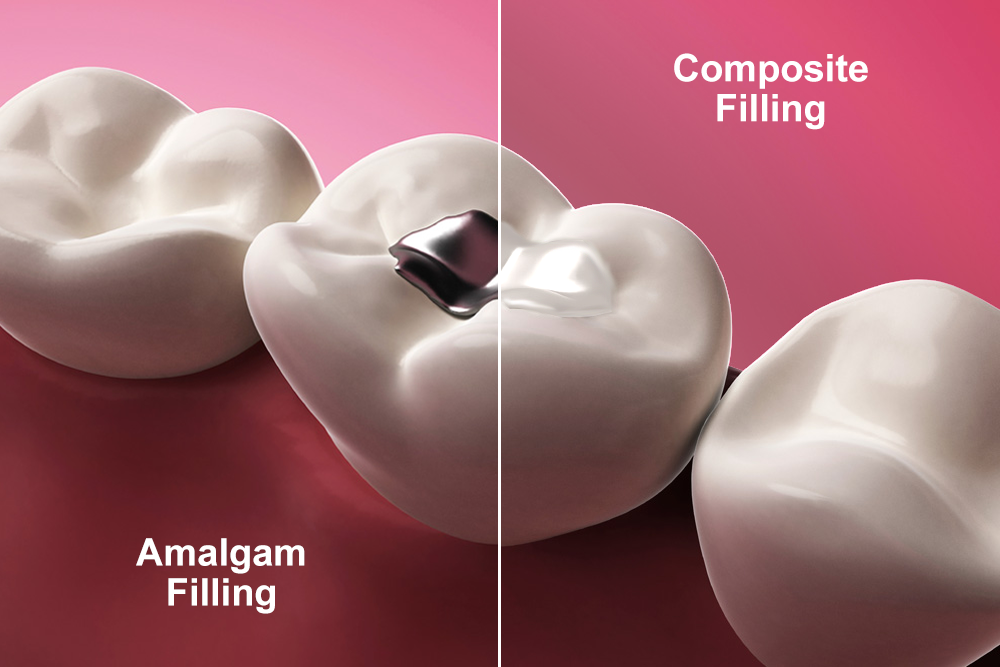Considering Replacing Your Old Fillings? Amalgam vs. Composite Filling
 In the past, dentists used amalgam, or silver, fillings to treat cavities. Today, composite, tooth-colored fillings are used because they offer improved aesthetics. If you still have metal fillings, you may want to weigh the benefits of amalgam vs. composite fillings.
In the past, dentists used amalgam, or silver, fillings to treat cavities. Today, composite, tooth-colored fillings are used because they offer improved aesthetics. If you still have metal fillings, you may want to weigh the benefits of amalgam vs. composite fillings.
Both have been proven to be safe and effective restorative dentistry materials. Even so, knowing the differences between the two can help patients decide if they want to replace their old fillings.
Composite, or tooth-colored fillings, are often chosen because they offer a more natural-looking appearance. Additionally, this option is often preferred by patients who do not want to have fillings that contain mercury.
To schedule a consultation, contact the Smile Center in Virginia Beach, VA.
Amalgam Fillings
Amalgam has been used extensively in restorative dental care for more than 150 years. The material contains liquid mercury which is mixed with a metal alloy powder predominantly made up of silver, tin, and copper.
Amalgam has a claylike consistency when it is mixed. It starts to harden almost immediately after placement, and within an hour or two, it becomes extremely hard and resistant to chewing forces.
A Strong, Durable Material
Amalgam is strong, durable, and easy to work with. It also has another important advantage: amalgam possesses the unique characteristic of corroding at the margins where it contacts the tooth. This corrosion is beneficial because it seals the edges, lessening the chances of recurrent, or new, decay developing around the filling.
Drawbacks Regarding Preparation and Appearance
In contrast to composite, the amalgam material does not bond directly with the tooth. Instead, the restoration must be retained by undercuts and grooves made to the tooth during its preparation. This means that more of the tooth's healthy structure must be removed to attain retentive strength.
Another disadvantage of amalgam is the dark, noticeable color. There is also a tendency for silver fillings to stain the adjacent enamel so that it takes on a dark gray color. Even if the restoration itself is placed in a location where it cannot be seen, the stain it causes may be visible.
Concerns Over Safety
A final concern regarding amalgam relates to its safety. The liquid mercury it contains is a toxic substance. However, the low level is considered to be safe.
Despite the presence of mercury in amalgam filling material, studies show it is not a significant health concern. The U.S. Food & Drug Administration (FDA) has performed an exhaustive review of related scientific literature and found insufficient evidence supporting the fact that amalgam fillings containing mercury have adverse health effects.
There were, however, some exceptions. Women who are pregnant, children under the age of six, and patients who are routinely exposed to mercury or who have a diet that consists largely of seafood (which can contain high levels of mercury) should avoid amalgam filling material.
Other agencies and organizations, including the American Dental Association (ADA) and the Centers for Disease Control and Prevention (CDC), have released similar statements.
Composite Resin Restorations
Tooth-colored plastic materials have been widely used in dentistry since the 1990s. Like amalgam, the dentist mixes this material chairside and places the filling while it is in a soft, putty-like state. Within minutes, the material hardens to nearly its maximum strength.
Natural-looking and Conservative
Composite resins have the obvious advantage of being tooth-colored. The material is available in various shades so it can be precisely matched to the patient's natural tooth.
Another advantage of composites is that they can be bonded in place with an acid-etching process. This means that they can essentially be glued to the tooth structure and do not require large, undercut tooth preparations for retention. As a result, these fillings can be very small and the preparations conservative.
Preserve Your Oral Health
Both amalgam and composite are safe and effective materials for dental fillings. Weighing aesthetics, longevity, and cost can help you choose which type is best for your needs.
To schedule an appointment, contact us online or call us at (757) 473-8482.


